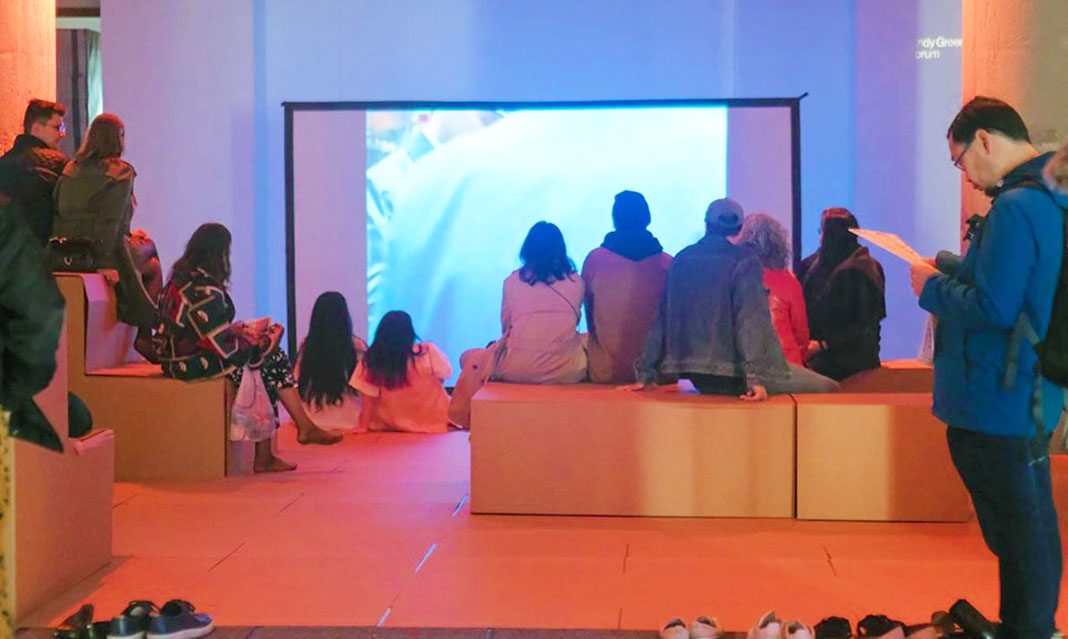Under a haze of red muted light, Kidlat Tahimik’s 1977 cult film Perfumed Nightmare plays on repeat from a projector. Between the four pillars that section this space off from the rest of the Museum of Contemporary Art’s lobby, unfolded boxes lay on the floor in neat tiles. On top of the makeshift cardboard mat, folded cardboard box chairs invite museumgoers to sit and watch the film from artist Stephanie Comilang’s memoryscape. For Nuit Blanche 2019, Comilang’s video, light, scent, and textile installation “It All Makes Sense” is on view in the lobby of the MOCA in Toronto until October 13. Comilang describes viewing the film as an adolescent as having profoundly changed her life, and the exhibit serves to recreate the memory of her first time viewing Perfumed Nightmare. It is from this shared lens that I watched the film.
Shot with a $10,000 budget on 16mm film, the semi-autobiographical, coming-of-age drama Perfumed Nightmare takes place in 1942 and follows Kidlat (portrayed by and named after the director), a Filipino teen born in Balian, a town that worships Western cultural and technological innovation, to the extent that it erects an imitation Statue of Liberty in the town square. Growing up, Kidlat, our idealistic and ambitious protagonist, is enveloped in a “cocoon of Americanized dreams” which motivates him to emigrate to Europe and start a gumball business there. Kidlat plans to travel on toward America after a year, but he learns that ushering in the New and Modern means exiling the Familiar and Traditional. When his sugary gumball bubble of enchantment popped, Kidlat becomes disillusioned by American cultural colonialism, late capitalism, and the technological innovation and industrialization that ever-deepens the divide between the first and third world. After this realization, Kidlat returns to the Philippines and begins anew to define his place in the world, and his view of it.
Director Werner Herzog has hailed Perfumed Nightmare as “one of the most original and poetic works of cinema made anywhere in the seventies,” and critic Gene Youngblood described it as “a bizarre, hallucinatory movie full of dazzling images and outlandish ideas. It’s both real and surreal, poetic and political, naive and wise, primitive and supremely accomplished… a dazzling testament to the liberty of the imagination.” Writer Susan Sontag says the film “reminds one that invention, insolence, enchantment, even innocence, are still available to film.” While I am certainly not as well-watched or good with words as any of them, I must vouch for the film as well.
Beyond its breathtaking, cinematic shots of Balian, Paris, and Berlin, the film is a fresh look at the modern world that nudges viewers to be cautious of the pitfalls of Western cultural capitalism, which can overwrite self-determination and cultural memory. The film begs the question of what has been lost amidst the gains of late capitalism and technology, and invites you to define your own level of intake and influence from the dominion of the two.
I thank Comilang for introducing me to Perfumed Nightmare and giving me the space to watch it. I viewed the film from a cardboard box chair chosen because it was shaped like a Tetris block. From the installation’s placard, I learned that the boxes reference balikbayan corrugated boxes, packaging typically used to send items back to loved ones in the Philippines, and refer to “an act of exchange, and the sending and sharing of care back home.”
The boxes may have made uncomfortable chairs, but I thought them a lovely tribute to the Philippines and, more broadly, any country that museumgoers or museumgoers’ families may have immigrated from; any country that may be portrayed as lacking something in a cocoon of Westernized wants and dreams; any country that in fact has its own abundance of beauty and tradition to appreciate independently. As I write this, it is the last day of the installation’s run, so sadly, if you are reading this, you have missed out on the memoryscape created by Comilang. But you can still watch Perfumed Nightmare in its entirety on Vimeo, and you have my recommendation to do so.



